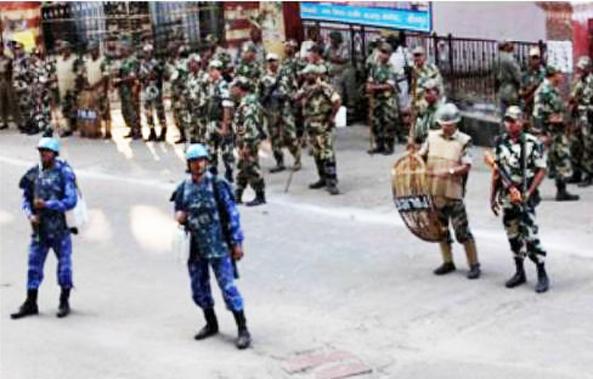Srimad-Bhagavatam, 5.19.2 — […] The residence of Lord Ramachandra on this planet is Ayodhya. Ayodhya City is still existing in the district of Hyderabad, which is situated on the northern side of Uttar Pradesh. Full Purport
![]()

"Security personnel outside the Lucknow Bench of Allahabad High Court during the pronouncement of the Ayodhya verdict, in Lucknow on Thursday. (PTI Photo) "
HC partitions disputed Ayodhya site; 2 parts to Hindus, 1 part to Muslims
Manoj Mitta, TNN, Oct 1, 2010, 01.10am IST — Sixty years after Ram’s idols were forcibly installed under the central dome of the Babri Masjid, the Allahabad high court, in a judgement running into about 12,000 pages, paved the way on Thursday for the construction of a temple at that very spot which is believed by many Hindus to be his birthplace.
While disposing of four title suits, the majority of the three-judge bench directed that the disputed site of 2.77 acres in Ayodhya be partitioned equally among three parties: Muslims, Hindus and Nirmohi Akhara (a Hindu group). (Read judgement)
In deference to the widely-held belief about Ram’s birthplace, the court stipulated that the crucial area under the central dome of the mosque demolished by kar sevaks in 1992 be allotted to Hindus. This means the idols will remain where they are.
In the course of the partition due to take place after three months, the court directed that Nirmohi Akhara be allotted parts of the outer courtyard covered earlier by Ram Chabutra, Sita Rasoi and Bhandar, which had long been used for worship by Hindus despite their proximity to the mosque.
Thus, the separate judgments delivered by Justice S U Khan and Justice Sudhir Agarwal, constituting the majority opinion of the bench, have in effect allotted two-thirds of the disputed site to Hindus even as they opened up the possibility of the mosque being rebuilt on the remaining part.
The dissenting verdict given by Justice D V Sharma, however, rejected the claims of Muslims on the ground that Babri Masjid had been built against the tenets of Islam and therefore could not be treated as a mosque.
Declaring that the entire premises belonged to Hindus, Sharma’s dissent held that the mosque had been built by Mughal emperor Babar after demolishing what was found by the Archaeological Survey of India to be a “massive Hindu religious structure”.
Given the difficulty involved in carving out a one-third share for Muslims from the remaining parts of the disputed site, the majority verdict of Khan and Agarwal clarified that a part of the outer courtyard which was in the possession of Hindus could be given to Muslims.
If that did not make up for the shortfall in the one-third share allotted to Muslims in the disputed site of 2.77 acres, the court envisaged the possibility of their being compensated with a portion of the adjoining 67.7 acres of land which had been acquired by the Centre in 1993 with the intention of providing access and facilities for both communities.
The court gave liberty to all the parties concerned to file suggestions within three months on the actual partition of the disputed site and directed that status quo be maintained during that period.
(Ayodhya verdict: The view from Ground Zero)
Though the operative parts of their judgments are similar, Khan and Agarwal differed in the manner in which they arrived at their conclusions. While Khan declared that both Muslims and Hindus were “joint title holders in possession of the entire premises in dispute”, Agarwal held that only “the area within the inner courtyard” belonged to both communities as it had been used by them for centuries.
Khan and Agarwal also differed over whether a temple had been demolished to build the mosque. In Khan’s opinion, the mosque was built on the ruins of temples which had been lying in that condition for a long time. Agarwal, on the other hand, agreed with Sharma that a temple had been demolished to build the mosque.
Khan held that it was only after the mosque had come into existence did Hindus start identifying the disputed structure as the exact birthplace of Lord Ram. Before that, their belief about the birthplace “did not relate to any specified small area” in or around the disputed premises.
Since Ram Chabutra and Sita Rasoi came into existence long before the first legal dispute arose in 1855, Khan said Ayodhya for long displayed a “very, very unique and absolutely unprecedented situation” in which Hindu religious places were being worshipped inside the compound of a mosque.







pamho agtacbsp i been there in 1987 and ayodhya dham were already full of dangers a lot police around the city i see in the indian newspaper sadhu with broken heads i left ayodhya and went in vrindavan and a similar story happens 200 km far from vrindavana the hindu got fed up about the muslim atrocities in their temples they use to steal the deity etc.. the hindu burn alive all the muslim who done that they left just women and children alive, i know is very bad to see this conflict still going on between muslim and hindu that’s everywhere not just in india her in london also fighting anyway i been lucky to come back safe from ayodhya dham because i didn’t know nothing about the fighting before to go there krsna mercy